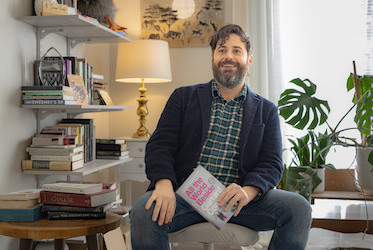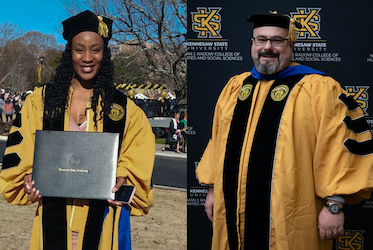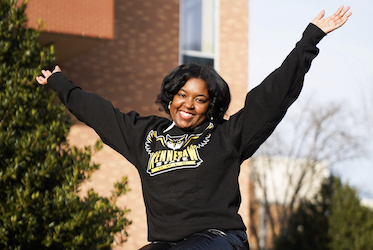
Destined Document
KENNESAW, Ga. | Mar 28, 2018
17th century British deed binds two KSU faculty members
Call it serendipity. Or maybe providence. Whatever explains how a 362-year-old document would find its way through time and across the Atlantic from England and connect two Kennesaw State University faculty members who were virtual strangers suggests that something beyond coincidence is at play.
The document, an ornately hand-scripted deed printed on a sturdy, specially treated animal skin called vellum, began the Georgia leg of its journey 39 years ago when Peter Fenton, an assistant professor of criminal justice, lawyer and former law enforcement official, received it from a “dear uncle” as a present when he graduated from Emory Law School. As a collector, Fenton’s uncle searched around for something that would have meaning for a new lawyer and something that might one day have value.

“Now, I had enough legal understanding to determine from the word indenture on the document that it was some kind of deed,” Fenton said. “But I was young and just out of school, so I tucked it away in a cardboard box until I could one day afford to get it framed.”
When Fenton moved about a year ago, he found the document in that box in the attic. He wondered if it was really anything of value.
“Maybe I’m the rightful owner of Buckingham Palace and they owe me rent,” he quipped. “It just might be my retirement fund. I thought I should find out. What have I got to lose?”
Fenton contacted Dave Parker, assistant chair of the Department of History and Philosophy, who told him without pause, “Stephen Bartlett is your man.”
Anyone entering the office of Bartlett, a senior lecturer of world history, would know instantly his affinity for history, especially for medieval times and European antiquity. Framed documents line the walls and neatly arrayed volumes of history share shelves with artifacts and memorabilia reflecting a collector’s sensibility. He says he frequently uses the documents in his classes to let students “feel and touch” history.
When Fenton hand delivered his document, Bartlett said he took one look at it and knew he would be the bearer of bad news.
“You can buy these things a dime a dozen on the Internet,” he said. “There are thousands of them out there.”

Sparing Fenton the news for the moment, Bartlett agreed to take a closer look after Fenton left. As he scanned the multiple rows of carefully written script, Bartlett said his eyes were drawn to a few startling details. First, it was dated in 1656. The name of the seller, Johnny Bartlett, was making a complicated transaction with Thomas Barnard involving at least six other indebted families. Then came the real stopper: The deed was drawn in a town called Stopham, England.
“I was stunned,” said Bartlett, “because Stopham is just this little no-nothing hamlet in Southern England, a parish in the Chichester District of West Sussex with about 40 houses, a place that nobody knows anything about or visits – nobody except me that is.”
Bartlett had traveled to Stopham in 2005 to research his family lineage, which goes all the way back to William the Conqueror. Though Bartletts pop up here and there in history, he noted, it is a “minor family in the grand lineage of British royalty.” But the family history is well known in Stopham because it is the home of the original Bartlett family.
“I’m from a long line of Bartletts,” he said. “In fact, many of the town’s residents are Bartlett descendants. They all paint their front door and windowsills an oxblood color so people looking for Bartletts can find them. So, when I went there and knocked on one of the doors, they invited me in, took me into the backyard and showed me the lands of my ancestors.”
When the shock of his discovery wore off, Bartlett said he called to convey his excitement to Fenton, who was on his way to class. “I told him that while the document wasn’t worth much, I wanted him to know right away why it was worth a nice dinner out to me.”

Once face-to-face, Fenton described the moment that Stephen shared his discovery. “His eyes were all aglow and there was just the look of sheer delight on his face. It was just priceless. The hairs were literally standing on the back of my neck,” Fenton said. “I couldn’t believe the coincidence that I managed to find right here on this campus, the one person to whom this document would have meaning.”
Bartlett agreed. “It’s an incalculable coincidence that you would have walked into my office,” he told Fenton.
For his part, Fenton, at hearing Bartlett’s father was about to celebrate his 70th birthday and the son had not had time to find a gift, decided to make a gift of the document to the elder Bartlett.
“I didn’t get rich from it, but I am rich in the sense that the document has found its rightful home,” Fenton said. “This just proves that truth is sometimes stranger than fiction.”
Bartlett added, “To have this document just drop in as it did right at my dad’s birthday … you just can’t write this stuff.”
# # #
– Sabbaye McGriff
Photos by Rob Witzel
Podcast by Travis Highfield
Related Stories
A leader in innovative teaching and learning, Kennesaw State University offers undergraduate, graduate and doctoral degrees to its more than 45,000 students. Kennesaw State is a member of the University System of Georgia with 11 academic colleges. The university’s vibrant campus culture, diverse population, strong global ties and entrepreneurial spirit draw students from throughout the country and the world. Kennesaw State is a Carnegie-designated doctoral research institution (R2), placing it among an elite group of only 7 percent of U.S. colleges and universities with an R1 or R2 status. For more information, visit kennesaw.edu.



















